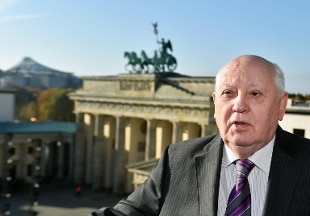Share
December 25, 2021 It was December 25, 1991. It was 7:32 pm and
Gorbachev
appeared on television to announce his resignation and with that the end of the Soviet Union. The Soviet red banner was lowered by the Kremlin for the last time and replaced with the Russian tricolor flag. The following day, the upper house of the Supreme Soviet recognized the autonomy of government of the former Soviet republics, formally dissolving the Union. Gorbachev resigned and handed over his presidential powers, including control of nuclear launch codes, to
Yeltsin,
who was president of the Russian Federation until 1999.
The
"perestroika"
, launched by Mikhail Gorbachev in 1985 - the reform program aimed at freeing the economy within the communist regime-, and the
"glasnost"
(opening of historical archives, publication of previously banned books, reduction of censorship) - they had revitalized the role of the USSR on a world level and had somehow blocked its decline. This was countered by the damage caused by decades of arms race and mismanagement and the economy showed drastic signs of wear. In addition, the unity of the 15 Soviet republics, whose Communist propaganda was growing strong, was melting like snow in the sun.
The Caucasus region rebelled against Moscow, followed by the Baltic countries and Lithuania declared its independence. A threat too great for the
USSR
so much so that in January 1991, Moscow intervened by force, shooting at the demonstrators. The attempt to quell the insurrection failed and Lithuania became the first republic to officially break away from the USSR and restore independence.
On August 19, 1991, the coup d'état arrives: the Soviet people wake up to the TV broadcasting "Swan Lake" from the Bolshoi theater, prologue to the announcement in which it is declared that Gorbachev is unable to govern for reasons of health. Thus was born the "
State Committee
", created to save the country from" chaos and anarchy ", at least according to the proclamations. Meanwhile, columns of tanks enter Moscow, public meetings are banned and the pro-reform newspapers closed. The capital thus passes by the changes of Gorbachev , which had led to a real political effervescence, a real occupation.
The coup d'état ends however in just two days but is believed to have paved the way for events that would have ended the existence of the Soviet Union. Boris Yeltsin , elected president of
the Russian Federation
in June 1991
, manages to dissuade conservatives from the reckless gesture, with the direct consequence that his political influence grows enormously. However, the Russian crisis is further amplified due to the now cracked unity that keeps the country standing and which would soon have resolved itself in an internal fracture, and which will lead to the establishment of numerous satellite states.
The secession of the Baltic states was recognized in September 1991 The Belovezha Accords were arbitrarily signed on December 8 by Yeltsin, Ukrainian President Kravchuk and Belarusian President Shushkevich, recognizing mutual independence and creating the Commonwealth of Independent States (CIS ).
Kazakhstan
it was the last nation to leave the Union, proclaiming independence on December 16: all the republics, with the exception of Georgia and the Baltic countries, joined the CIS on December 21, signing the
Alma-Ata
declaration
.

